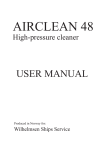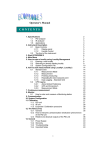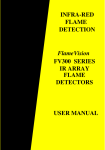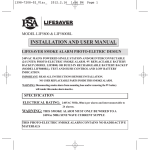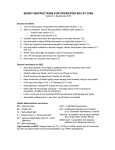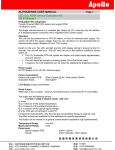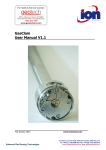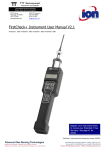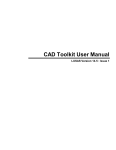Download MiniPID User Manual V1.9
Transcript
MiniPID User Manual V1.9 Intrinsically Safe Volatile Organic Compound (VOC) Sensor Register your instrument online to receive your Extended 2 Year Warranty. See page 19 for details. Mini PID User Manual Part Number: 846236 Mini PID Std/Reg Ion Science Ltd Page 1 of 23 Mini PID Std/Reg Ion Science Ltd Declaration of Conformity Manufacturer: Ion Science Ltd, The Way, Fowlmere, Cambridge, SG8 7UJ, UK Product: MiniPID Std or MiniPID Reg Product Description: Intrinsically safe photo-ionisation sensor for volatile organic compounds Directive 94/9/EC ATEX o Notified Body: o II 1G Ex ia IIC T4 (-40 C ≤ Ta ≤ +55 C) @ 1.1W limitation o o (-40 C ≤ Ta ≤ +65 C) @ 0.9W limitation Identification: Baseefa Ltd, 1180, Buxton, UK Intertek, Cortland, NY 13045, USA EC Type Examination Certificate(s) th Baseefa07ATEX0060U – latest supplement Baseefa07ATEX0060U/3 issued 24 September 2008 Ref Baseefa Cert Report 07(A) 0688, 10(T) 0168 th IECEx BAS 07.0030U – latest revision no.4 issued 28 May 2010 Ref IECEx Text Reports GB/BAS/EX TR07.0056/00 TR07.0146/00 TR07.0181/00 TR08.0135/00 TR03.0195/00 ETL & cETL Test Report No. 3176983CRT-003 Issued May 2010 Standards BS EN 60079-0:2006 Electrical Apparatus for Potentially Explosive Atmospheres – General Requirement BS EN 60079-11:2007 Explosive Atmospheres - Equipment Protection by Intrinsic Safety ‘i’ BS EN 61010-1:2001 Safety requirements for electrical equipment for measurement, control and laboratory use – General requirements UL913; 2 nd Edition Intrinsically safe apparatus and associated apparatus for use in Class I, II, III, Division 1, Hazardous (Classified) Locations CSA-C22.2 No157-92 Intrinsically safe and non-incendive equipment for use in Hazardous Locations (Update 2) Other Standards BS EN ISO 9001:2008 BS EN 13980:2002 Quality Management Systems – Requirements Potentially Explosive Atmospheres – Application of Quality Systems On behalf of Ion Science Ltd, I declare that, on the date this product accompanied by this declaration is placed on the market, the product conforms with all technical and regulatory requirements of the above listed directives. Name: Mark Stockdale Signature: Position: Technical Director th Date: 11 August 2010 Page 2 of 23 Doc. Ref. 846238 issue Mini PID Std/Reg Ion Science Ltd Contents Declaration of Conformity .......................................................................................................................... 2 Statements ................................................................................................................................................... 4 Responsibility for Use ................................................................................................................................ 4 Introduction .................................................................................................................................................. 5 Applications ................................................................................................................................................. 5 Features ........................................................................................................................................................ 5 Physical Properties ..................................................................................................................................... 6 Specification ................................................................................................................................................ 7 Common Electrical Specifications: ............................................................................................................ 7 Gas Detection Specifications (specific): .................................................................................................... 8 Average linearity of response .................................................................................................................... 9 Natural physical effects of humidity ......................................................................................................... 10 Schematic Block diagram ........................................................................................................................ 10 Instrument Interfacing – Application Notes ............................................................................................ 11 Selecting the correct supply voltage for your miniPID ............................................................................. 11 Power-up surge ........................................................................................................................................ 11 Analogue output ....................................................................................................................................... 12 Temperature correction............................................................................................................................ 12 Mechanical installation ............................................................................................................................. 13 Sealing the PID ........................................................................................................................................ 13 PCB layout for EMC noise reduction ....................................................................................................... 14 Intrinsic Safety circuit implementation ..................................................................................................... 14 Maintenance ............................................................................................................................................... 16 When does my MiniPID require maintenance? ....................................................................................... 16 When do I clean the MiniPID lamp? ........................................................................................................ 16 When do I replace the MiniPID electrode pellet? ................................................................................... 16 Removing Mini Pellet and Lamp .............................................................................................................. 16 Cleaning the MiniPID Lamp ..................................................................................................................... 17 Re-fitting MiniPID pellet and lamp ........................................................................................................... 18 How does it work? ..................................................................................................................................... 19 What is a volatile organic compound (VOC)? .......................................................................................... 19 What is a response factor? ...................................................................................................................... 20 Instrument Warranty and Service ............................................................................................................ 21 Warranty................................................................................................................................................... 21 Service ..................................................................................................................................................... 21 Contact Details ......................................................................................................................................... 21 Manual Log ................................................................................................................................................. 22 Page 3 of 23 Mini PID Std/Reg Ion Science Ltd Statements Responsibility for Use Inadequate performance of the gas detection equipment described in this manual may not necessarily be self-evident and consequently equipment must be regularly inspected and maintained. Ion Science recommends that personnel responsible for equipment use institute a regime of regular checks to ensure it performs within calibration limits, and that a record be maintained which logs calibration check data. The equipment should be used in accordance with this manual, and in compliance with local safety standards. Legal Notice Whilst every attempt is made to ensure the accuracy of the information contained in this manual, Ion Science accepts no liability for errors or omissions, or any consequences deriving from the use of information contained herein. It is provided "as is" and without any representation, term, condition or warranty of any kind, either express or implied. To the extent permitted by law, Ion Science shall not be liable to any person or entity for any loss or damage which may arise from the use of this manual. We reserve the right at any time and without any notice to remove, amend or vary any of the content which appears herein. Page 4 of 23 Mini PID Std/Reg Ion Science Ltd Introduction MiniPID is a miniature photoionisation sensor. Sample gas freely diffusing through the filter membrane at the top of the sensor, is exposed to deep ultraviolet light generated by a lamp within the sensor. The emitted light ionises targeted gases in the sample so they can be detected by the gas detector and reported as a concentration (eg ppb, ppm or 3 mg/m ). Chemicals such as volatile organic compounds (VOCs) with an ionisation potential less than or equal to 10.6 eV will be detected by the MiniPID. The MiniPID can be installed in portable and TM TM stationary gas monitors that accept either Alphasense Ltd CH-A3 or City Technology 4P pellistor cells, providing complete PID capability in a package that has the same dimensional and electrical profile as pellistors (provided the electronics input circuit is designed to take the sensor’s output range). This opens up an incredible variety of environmental and safety applications in industrial, commercial and residential markets. The MiniPID sensor is offered in two models having the guaranteed range of operation below. They are virtually insensitive to humidity changes, providing unparalleled performance in a variety of applications. The Mini PID LO has a dynamic range of <100 ppb to >4,000 ppm (isobutylene). The Mini PID HI has a linear dynamic range of <5 ppb to >50 ppm (isobutylene). Please contact Ion Science at www.ionscience.com for a comprehensive list of response factors for various VOCs. The miniPID sensor pack includes a sensor incorporating a 10.6 eV lamp, lamp driver, amplifier circuitry and removable electrode stack with particulate filter and electrode stack removal tool. Features Applications Patented guard electrode for excellent humidity immunity Reliable lamp – illuminates at low temperatures Superior lamp life User-replaceable electrode stack keeps your PID working, even after bad contamination Intrinsically safe (ATEX, IECEx, ETL, CETL) Bulb out error detection (MiniPID LO only) Page 5 of 23 Industrial hygiene & safety monitoring Soil contamination and remediation Hazmat sites and spills Low concentration leak detection EPA Method 21 and emissions monitoring Arson investigation Indoor air quality monitoring Mini PID Std/Reg Ion Science Ltd Physical Properties The illustration shows the gas sensing pellet head at the top of the MiniPID. The gas enters the small circular hole in the middle. A flat face is provided to allow for sealing in manifold pumped systems. The pellet slatted side wing mountings are clearly seen and also the side slot is just visible on the lefthand side in the black section showing where the tool must be located in both sides to release the pellet. The tool inserted here and pressed will quickly release the pellet and allow instant access to the lamp. LEL equivalent mechanical format Base view Outside dimensions and pin configuration as per industry standard series 4 LEL sensor Pin Details 1 Positive Supply Voltage 2 Signal Output 3 0V Ground Note: Hashed area is the preferred sealing location for an O’Ring. Bullet points of distinction:Ion Science Standard Versions: MP3SM6FB Mini PID 3-pin ppm (3V to 3.6V certified) MP3SM6FC Mini PID 3-pin ppm (3.6V to 10V certified) MP3SM6FN Mini PID 3-pin ppm (3.6V to 18V non certified) MP3SB6FB Mini PID 3-pin ppb (3V to 3.6V certified) MP3SB6FC Mini PID 3-pin ppb (3.6 to 10V certified) MP3SB6FN Mini PID 3-pin ppb (3.6 to 18V non certified) Hazardous Locations Approvals: ATEX Approved Baseefa 07ATEX0060U IECEx Approved BAS07.0030U II 1G Ex ia IIC T4 Intertek Class 1 Div 1 Groups A, B, C, D T4 Conforms to UL standard 913 Certified to CSA standard C22. 2 No. 157 -40°C ≤ Ta ≤ 55°C 1.1 W (to 65°C @ 0.9 W) Version MAY 2010 Patents: US 7,046,012 EC 1474681 Input power: 3.3 V+ 0.3 V / - 0.2 V. Stable (noise free) 3.6 V to 10 V (IS) or 18 V (safe zone). 120mA max power-up surge for 0.3s 33mA typical under continuous operation Page 6 of 23 Mini PID Std/Reg Ion Science Ltd Specification Common Electrical Specifications: Supply Voltage on pin 1 Ref to 0 V on pin 3 MiniPID supply VS o Current drawn (at VS = 3.3 V, 20 C) IS Power consumption (at VS = 3.3 V) P Peak current at power-up IM MiniPID Reg. supply VS Current drawn IS Peak current at power-up IM Current Construction Drift IΔT 3.3 V+ 0.3 V / - 0.2 V stable (noise free). 24 mA to 33 mA at VS = 3.3V, 110mW (typical) 120 mA for 0.3 s maximum. 3.6 V to 18 V (variable) maximum. 30 mA 3 mA (independent to VS) 120 mA for 0.3 s maximum. 1.5mA/10°C typical Voltage on Signal Output pin 2 Ref to 0 V on pin 3 Linear signal output: VSO > 50 mV to Positive Supply Voltage (less 0.1V) Stepped error states: VEO < 40 mV Output capacitance: CO 1.0 uF through 4k7 + 0.11 uF at pin Output resistance: RO 6k3 Output clamp: VOC 5V1 zener protected by 4k7 resistor. Supplementary Intrinsically Safe Specifications: Approval ATEX Approved Baseefa 07ATEX0060U Intertek Class 1 Div 1 Groups A, B, C, D T4 IECEx Approved BAS07.0030U Conforms to UL standard 913 II 1G Ex ia IIC T4 Certified to CSA standard C22. 2 No. 157 Temperature range -40C ≤ Ta ≤55C (note: Pi where Ta may be taken to 65°c) Supply Voltage on pin 1 Ref to 0 V on pin 3 MiniPID Standard (with solder blob) Voltage (Max) Ui 5.0 V Current continuous (Max) Ii 220 mA Power (Max) Pi 1.1 W @ +55 °C, 1.0 W @ 60C; 0.9 W @ 65C; Current surge (Max) Surge < 3.3 A Capacitance (Max) Ci 7.0 uF Inductance (Max) Li 0 uH MiniPID Regulated (without solder blob) Voltage (Max) Ui 10.0 V Current continuous (Max) Ii 220 mA Power (Max) Pi 1.1 W @ +55 °C, 1.0 W @ 60C; 0.9 W @ 65C; Current surge (Max) Surge < 3.3 A Capacitance (Max) Ci 1.1 uF Inductance (Max) Li 0 uH Voltage (Max) Ui 10.0 V Current continuous (Max) Ii 10 mA Power (Max) Pi 50 mW Capacitance (Max) Ci 0.12 uF Inductance (Max) Li 0 uH Note: “Signal Output pin 3” Ci to be summed with “Supply Voltage pin 1” Ci above (not countable fault) Schedule of Limitations The component must be mounted within apparatus which provides ingress protection of at least IP20, protection against impact, and protection against possible electrostatic charging of the plastic enclosure. Warning: The MiniPID sensor is an Intrinsically Safe device that contains limited energy storing components. An appropriate Intrinsically Safe interface must be employed for use in hazardous locations noting power limitations and temperature ranges, and must be installed in strict accordance with applicable safety codes and guidance given in the Manual. Failure to observe this warning can result in serious injury and/or property damage. Version MAY 2010 Page 7 of 23 Mini PID Std/Reg Ion Science Ltd Specification Gas Detection Specifications (specific): Transducer Details (ref Isobutylene) Minimum Detection Level Linear Range (±3% deviation) Minimum over-range Over range typical Sensitivity (Linear range) Full Stabilisation Time HI to 20 ppb, LO to 100 ppb) Warm-up Time Offset Voltage Response Time in diffusion mode(t90) Offset Voltage SD RL RO RT S TS TW VOS TR VOS MiniPID HI 5 ppb full range 50 ppm 80 ppm > 25 mV/ppm 5 min <5s 60-70 mV <3s 60-70 mV MiniPID LO 100 ppb 100 ppm 4,000 ppm 10,000 ppm > 1 mV/ppm 10 s <5s 50-51 mV <3s 50-51 mV Gas Detection Specifications (general): Target Gases VOC’s with ionisation potentials < 10.6 eV o o Temperature related response variance ±10% between -20 and 60 C, vs 20 C response (please check item 4 on page 14) Relative humidity range 0 to 99% RH, non-condensing Product Specifications (general): Lamp replacement Electrode Stack Onboard filter (within disposable pellet) Package Type mm high Weight Positional Sensitivity Warranty User replaceable (10.6 eV) User replaceable Removes liquids and particulates TM TM Alphasense CH-A3,City Technology 4P, 20 mm dia x 16.6 <9g None 12 months from date of shipment. (Please see page 21 for details on extended warranty) ! Caution ! Note on Silicones: PIDs are not permanently damaged by Silicones but they do potentially foul the windows of the lamps and reduce response to some gases. This can usually be remedied by polishing the lamp window with alumina powder. However, instrument manufactures incorporating the miniPID sensors should be careful to avoid any silicones even as may occur in labels, and plastics such as from moulding release agents. Over months of storage the silicones may leach into the sensor and lead to window fouling and sensitivity lost. Ordering parts: Mini PID HI PID: 5 ppb to 50 ppm range. Includes bulb and electrode stack. Mini PID LO PID: 0.1 ppm to 4000 ppm range. Includes bulb and electrode stack. LA4SM600 Replacement bulb. 10.6 eV only. MSF Replacement electrode stack. 846216 Extraction tool required for replacing bulb or electrode stack. 846217 Replacement spring. A-31063 PID Lamp Cleaning Kit Page 8 of 23 Mini PID Std/Reg Ion Science Ltd Specification Average linearity of response Average temperature variance This graph here shows temperature effect on response of a miniPID powered initially at o 20 C, and continually powered during the change of temperature to the indicated temperature. Error bars indicate variance between PIDs. The graph here shows the same effect of temperature, except that after temperature equilibration, a PID us repowered (powered of and on.) This confers less of a temperature effect and is recommended. Page 9 of 23 Mini PID Std/Reg Ion Science Ltd Specification Natural physical effects of humidity Water is not itself detected by PID, but it adsorbs a portion of the light that otherwise promotes a response from a photoionisable gas. The response of the MiniPID to humidity can be adjusted according to the figures presented below, for o Fahrenheit and Celsius temperatures. For example, it can be seen that at 80 F and 90% relative humidity (RH), a response is decreased from that in dry air by 20%. This effect will be the same for any detectable gas. 95 30 oF 90 50 oF 85 70 oF 80 o 80 F 75 o 90 F 70 100 oF 65 60 55 50 0 10 20 30 40 50 60 70 80 90 percentage of response at RH = 0 percentage of response vs dry air 100 100 10 oC 95 90 20 oC 85 80 o 30 C 75 o 40 C 70 65 60 55 50 100 0 Relative humidity, R.H., % 10 20 30 40 50 60 70 Relative humidity, R.H., % Schematic Block diagram Page 10 of 23 80 90 100 Mini PID Std/Reg Ion Science Ltd Instrument Interfacing – Application Notes This section explains how to connect electrically and mechanically the PID to your gas detector. Please also take careful notice in the differences stated when a MiniPID is used in a Safe Zone and where it might be also be used in a flammable atmosphere (Intrinsically Safe operation). Selecting the correct supply voltage for your miniPID The MiniPID module is protected from power supply reversal on any pins provided the supply is limited to the rated voltage and the source current is limited to 150mA over several minutes. The supply is either internally or externally regulated, depending upon the infilling with solder a small circular ‘solder well’ located on the underside of the sensor. Note: The solder needs to bridge from the bottom to the upper layer but need not fill the hole completely. miniPID LO, Vs miniPID HI, Vs Checking the quality of solder joint Set DVM to resistance Soldered 3 to 3.6 V 3 to 3.6 V Pins 1 to 3 2 k (either way around) Unsoldered 3.6 to 18V 3.6 to 18V Pins 1 to 3 > 1 M (either way around) Supply voltage states, as circumscribed by infilling of the ‘solder well’. WARNING: Please also note intrinsic safety constraints on supply voltage as given elsewhere. Externally regulated voltage rail, Vs = 3 to 3.6 V. In this state, the cell must be supplied a stable source of voltage between 3.0 to 3.6 V as the internal voltage rail is determined by the externally supplied voltage, affecting lamp illumination and other circuits, and therefore determining the sensor response – thus allowing the user to trim the sensor to their particular requirements. All lamps are tested to operate at a minimum supply voltage of 3.0 V before they leave the factory. However, as lamps age, the minimum required operating voltage slowly increases until the lamp requires a voltage higher than the voltage rail supplied. Therefore a lower supply voltage will curtail lamp life and deliver decreased gas sensitivity, but it will extend the measuring range of the sensor and of course require less power. Conversely, longer lamp usage by having a higher rail voltage to assist in lamp ‘start up’ from cold against the increased lamp power giving a less linear detection for high VOC concentrations In the case of the miniPID LO, the lifetime of the lamp can be monitored by using the lamp out diagnostic. It is recommended that the power supply is stable to within 10 mV (high frequency spikes can be 10 times greater than this). This will ensure that the digital drive circuit for the rf lamp oscillator remains in resonance, maintaining a stable lamp intensity. The reason for this value is that the resonant frequency may lie near a cusp of a discrete step change. Internally regulated voltage rail, Vs = 3.6 to 18 V. In this state, the miniPIDs can be operated between 3.6 and 18 V. The signal stability is unaffected by external supply drift as the sensor circuits are internally regulated to 3.3 V. Thus the user is completely free to select the most convenient supply for their needs. The internally regulated sensor is much more unaffected by power variance and can tolerate 1 V changes at low frequency. Clearly the designer should guard against high frequency transient spikes as these might punch their way through the internal regulator control circuits. Power-up surge While the PID takes only 33 mA 7 mA under normal operation over the full voltage supply, there is a power-up surge of about 120 mA (maximum) for about 300 ms while the MiniPID seeks resonance, thus consuming more current at power-up. Page 11 of 23 Mini PID Std/Reg Ion Science Ltd Instrument Interfacing – Application Notes Analogue output The output voltage range is from 0.0 V to Vs -0.1V for the externally regulated voltage range of Vs = 3.0 to 3.6 V, or 3.2 V, when internally regulated on a supply of 3.6 V to 18 V. The operating signal output signal is scaled from +50 mV because: a. The input amplifier has the best input bias current characteristics when biased at +50 mV. b. This allows the OEM external amplifiers to operate with their inputs above 0V for more flexibility. c. This allows the use of error status signal levels below the normal 50 mV base signal level. These error status levels are listed below. Error states (units shipped beginning 2009) Normal operation: signal output is between 50mV and (Vs – 0.1 V) externally regulated on a supply voltage of 3.0V to 3.6V or 3.2 V, when internally regulated on a supply of 3.6 V to 18 V. Voltages below 50mV indicate an error condition: 32 (4) mV indicates lamp out, but oscillator operating correctly. Change/Clean lamp. 22 (6) mV indicates the oscillator is not working – There are two fault levels here. (One fault state is a 5Hz rectangular pulse to 50 mV and the other is a dc level). Change the pellet and/or MiniPID. 2 ( 2) mV indicates power removed. Fault in OEM supply voltage. Note: Voltages outside these limits are not rigorously defined. Zero offset correction When determining VOC concentration, you must first subtract at least 50 mV from the MiniPID LO signal, and at least 60 mV from the MiniPID HI signal. The increased output voltage above the stated 50 mV minimum for the MiniPID is due to amplified electrode stack leakage current. When the cell is dirty then this current may increase to 52 mV for the MiniPID LO or to 70 mV for the MiniPID HI. The best way to zero this offset voltage is to apply clean gas and reset the zero outside the MiniPID to become this new offset voltage. Important note: The 2 mV and 20 mV increase from 50 mV is purely dependant upon cell contamination which can be one or more of the factors given below (where a+b are most dominant dependant upon the type of usage). a. Temporary contamination within the layers of the cell that requires some minutes of lamp illumination to burn-off this debris. b. Excessive permanent contamination through salts (or the suchlike) deposited along the walls bridging the fence electrode to reduce it effectiveness. The cell needs to be replaced if this is suspected to be the cause. c. A much lower signal caused by photo-ejection from the back-electrode that is used to monitor the status of the lamp condition to create our error status messages. This combined signal is part of the ‘lamp-out-detection’ circuit presently unique to this type of sensor and thus allows for continuous real time ‘in-cell’ monitoring. However, the end-user must be made aware that ‘lamp-out detection’ failing to occur can only be due to a heavily contaminated electrode stack – where surface leakage and/or salt build-up within the cell creates unwanted currents similar to that created by lamp illumination – thus always ensure a clean pellet is used. Excessive cell contamination can always be checked with the lamp removed but with the pellet in place to give a lamp error status in normal operation. Temperature correction Increasing temperature increases slightly the PID sensitivity. At 50C the sensitivity is about 1% higher than at 20C. Likewise, at -20C sensitivity will be 3% less than at 20C. This error is negligible and temperature correction can be ignored in all but the most demanding applications. Page 12 of 23 Mini PID Std/Reg Ion Science Ltd Instrument Interfacing – Application Notes Mechanical installation The electrical and mechanical considerations have been made simpler by designing compatibility with the standard LEL sensor configuration, thus it is possible to plug the PID into a standard 20mm diameter LEL sensor position and the PID detector will operate correctly, provided the OEM external signal conditioning circuit can operate under the stated output specification range of the PID. Always ensure that the interconnect pins are fully seated and that the sensor is fully secure to prevent unintentional movement or removal of the sensor by those unauthorised to do so. Sealing the PID The PID is designed to provide a good sealing area on the top face of the PID. It is important that when measuring VOCs with a downstream pump after the MiniPID that your sampling line is well sealed to the PID. Refer to the data sheet to ensure that you are sealing properly the PID without covering the gas access area. The sealed cavity is defined by the window face at one end, an O-Ring located around the outside of the window sealing to the volume that contains the electrode stack arrangement through the PTFE filter up onto the front face. It is at this front face the OEM designer must seal upon, ensuring that the seal lies within the three segmented arcs visible on the front face. This gives a very small detector cavity of about 3 15 mm that opens up many exciting possibilities for analytical work in pump drawn systems. Due to the potential for minor leakage through the layers within the cell, do not exceed 500 Pa (5 mbar) differential pressure between the PID and the gas detector internal cavity to ensure good signal integrity (within 1%). Typically 5000 Pa (50 mBar) gives (10%). Important note: While every care has been taken to ensure that the lamp sits abutted against the underside of the visible electrode, always ensure that the lamp is firmly pushed up against the underside of the visible electrode. Should the lamp not firmly abut the front electrode (relative to the lamp), then the user will experience severe degradation in accuracy (combined reduced signal levels and poorer linearity at high VOC concentrations). Incorrect abutment will also cause a loss in pneumatic sealing. Page 13 of 23 Mini PID Std/Reg Ion Science Ltd Instrument Interfacing – Application Notes PCB layout for EMC noise reduction To optimise the performance out of the PID it is recommended that micro-strip layout techniques be used to reduce susceptibility to emc noise: To minimise externally created noise superimposing itself onto the signal, the lines should be located close to the ground plane, balanced and directly coupled to a differential input Analogue-toDigital Converter (ADC) or differential input amplifier. A separate signal 0V line should be connected direct to the 0V pin of the PID and run parallel with the signal line to the differential input ADC or amplifier. This single pair of signal lines should ideally be located between two ground planes or at least run for its full length directly over the top of a ground plane. Since the PID responds in 50-100 ms, you can include an RC network on both signal lines located directly at the input of the differential input ADC or amplifier to remove 100Hz (and higher frequency) noise. While the MiniPID has its own internal screening, it is possible to achieve maximal noise reduction if the entire MiniPID sensor is mounted within a Faraday cage, which should be electrically connected to the ground plane. Very important Notes: 1. An electrically grounded Faraday cage is required for MiniPIDs mounted near to, or on the outside of an instrument for the sole reason of electro-static discharge that may falsely give a “Lamp-Out” error state. This is because electrical currents in the order of sub-picoamps generated within the sensing cell are being carefully monitored by the internal electronics for a “lamp-out” occurrence. Thus any spurious capacitive coupled emc discharge on an ungrounded case/covering will be transmitted to these circuits and cause a false “lamp-out” error message to be registered on the signal line of The MiniPID output. This will be seen by the signal step changing from about 52 mV to about 32 mV. The duration of this change will be dependant upon the severity of the close-coupled emc discharge – it is self resetting. This cannot be designed-out within the product because it is part of The Signal and any attempt to stop this other than by the use of a screening case over the whole product (particularly at the pellet) will also effect VOC generated signal. 2. Also RF interference may effect the resonance detection only in the first second of power-up. Thus the use of a Faraday cage will give more consistent calibrations because the same resonance frequency will be detected each time on power-up. Similarly circuits that use multiple MiniPIDs should have the power-up sequence for each module staggered by about 0.5 s to ensure that power supply current surges that may cause voltage dipping will not affect the common power rail to neighbouring modules. Or select the on-board regulator and supply with 5V or more - to provide the local isolation of 3.3 V inside. 3. It is advised that if the MiniPID has been off for a period of time to pulse the power ON for about 2 seconds, then off and back on again to allow the transformer to stabilise to an ideal working state. 4. For maximum repeatability in sensitivity then with ambient temperature excursions of greater than +/8°C from power up state it is recommended to turn off for 0.5 seconds and then turn power back on to reset oscillator to resonant frequency. Typically the MiniPID will be ready within another 0.5 seconds after application power off. Often this is implicit in the applications. Intrinsic Safety circuit implementation It is very important to abide by the stated temperature, power, voltage and current ratings. This product is designed to drop into a standard LEL sensor position, however: LEL sensors take considerable current and are often zoned by a separate 125 mA fuse and other suitable upstream voltage limiting devices. Depending upon the current required by the monitoring electronic circuits, the PID may either share the same zoned 125 mA fuse or the electronics can be located in another zone whose power is supplied by another fuse. If two zones are required, then very low current signals may be passed between the two zones by isolating resistors to limit any potentially shared high current between the two zones and thus maintaining separate zone integrity. Page 14 of 23 Mini PID Std/Reg Ion Science Ltd Instrument Interfacing – Application Notes Summary for use of the MiniPID in intrinsic safe applications. Maximum temperature for intrinsically safe operation. MiniPID is designed to have minimum response change over their full temperature range, and because performance of potting compounds changes with temperature, there is no potting compound in the sensor. However this meant serious design considerations were imposed on the Mini PID for its T4 temperature rating, due to the lack of internal space for components capable of operating at the 55C for 1.1 W T4 class (60 C for 1.0 W and 65C for 0.9 W). The MiniPID may be plugged directly into an LEL sensor PCB position whose power is supplied by an external 125 mA fuse for a T4 rating in an ambient temperature of up to 55C. The MiniPID is not rated above the power ratings given for the temperature limits because the internal zener diodes would exceed their rated temperature rise based upon the 3W zeners’ die temperature rating at the stated maximum ambient temperature when tested at the fused clamped current. Summary for use of the MiniPID in intrinsic safe applications. 1. External supply surge current must be limited to 3.3 A under fault conditions. 2. Depending upon maximum supply voltage, the MiniPID may use a 125 mA fuse in the supply line for 55C for 1.1 W T4 and a series resistor for reduced power limits for operation above 55C ambient temperature. 3. Take note of the various maximum supply voltages that may become connected to any of the pins under fault conditions. 4. Take note of the power limits of the various pins under fault conditions. 5. The capacitance is low and should not cause problems at these voltages. 6. If processing electronics are located in another zone, then barrier/ segregation resistors are required in any signal lines. 7. Competent third party assessment is required on the final product. 8. MiniPID Reg Working near 10V should have signal and power rails infallibly isolated to ensure lumped capacitances on an external short circuit does not exceed the safety current limit. Possible Intrinsically safe installations Equivalent Intrinsic Safe circuit Version MAY 2010 Page 15 of 23 Mini PID Std/Reg Ion Science Ltd Maintenance The electronics in the MiniPID sensor are designed to be maintenance-free and not accessible. Periodic sensor maintenance is required for the Mini Pellet and the lamp. When does my MiniPID require maintenance? Your MiniPID lamp will need cleaning from time to time. How often depends on the environment you are measuring. If you are measuring indoor air quality where the VOC concentrations are low and there are few particulates, then a monthly or even less frequent calibration may be adequate. However, if you are measuring high VOC concentrations and particulates are present in high concentration then check calibration frequently and when the PID has lost sensitivity or error state shows, change the stack as explained below. Signs when the PID needs attention: • If the baseline climbs after you zero the PID, then the electrode stack needs replacing. • If the PID becomes sensitive to humidity, then the electrode stack needs replacing. • If the baseline shifts/unstable when PID moves, then electrode stack needs replacing. • If sensitivity has dropped too much (note the change required when checking calibration), then the lamp needs cleaning. When do I clean the MiniPID lamp? Cleaning of the MiniPID lamp is recommended as a first action when presented with a MiniPID that needs cleaning. Use the procedure described below. It is recommended that a cell is recalibrated after cleaning a lamp, especially if the cell has been used for a few months since the sensor was last used. When do I replace the MiniPID electrode pellet? The MiniPID pellet can last the lifetime of the MiniPID if used in clean environments, or may only last a month if used in heavily contaminated sites. The electrode stack is a disposable item, so always hold a spare electrode stack if you are working in a dirty environment. If the cell shows signs of contamination after the lamp window has been cleaned, or is known to have been subjected to severe contamination, then it should be replaced. Instructions for replacing the electrode stack are below. It is recommended that the MiniPID is recalibrated after replacing the electrode stack. When do I replace the MiniPID lamp? A MiniPID will last a long time, typically a few thousand hours. Lamps are warranted for 6 months; replacement bulbs are available and are not expensive to replace. The sensitivity of the MiniPID is approximately in direct proportion to the lamp light intensity, so as a bulb fails, the response to a particular, low gas concentration becomes more noisy. Removing Mini Pellet and Lamp Caution: Always use the Pellet removal tool. Any other tools (for example screwdrivers) may damage your MiniPID body and will invalidate your warranty. 1. Gently remove the sensor from equipment. 2. Place the MiniPID, pellet side down, onto a clean surface. 3. Locate pellet removal tool into the side slots of the MiniPID and squeeze together until pellet and lamp are released. 4. Lift carefully the MiniPID body away from the pellet and lamp. 5. Occasionally the lamp may be temporarily lodged in the cell and will need to be freed carefully with tweezers. 6. Occasionally the small spring behind the lamp will come out when the lamp is removed from the sensor. Simply replace it in to the sensor house. Page 16 of 23 Mini PID Std/Reg Ion Science Ltd Maintenance Cleaning the MiniPID Lamp Inspection of the lamp may reveal a layer of contamination on the detection window that presents itself as a 'blue hue.' To check for contamination, hold the lamp in front of a light source and look across the window surface Only clean the lamp using our recommended lamp cleaning kit and detailed instructions. To avoid contaminating the sensor and affecting accuracy, do not touch the lamp window with bare fingers. You may touch the lamp body with clean fingers. PID lamp cleaning kit A-31063 The vial of cleaning compound contains alumina (CAS Number 1344-28-1) as a very fine powder. Cleaning should be undertaken in a well ventilated area. A full material safety data sheet MSDS is available on request from Ion Science Ltd. Key safety issues are identified below: Hazard identification: • May cause irritation of respiratory tract and eyes Storage: • Keep container closed to prevent water adsorption and contamination. Handling: • Do not breathe in the powder. Avoid contact with skin, eyes and clothing • Wear suitable protective clothing • Follow industrial hygiene practices: Wash face and hands thoroughly with soap and water after use and before eating, drinking, smoking or applying cosmetics. • The powder carries a TVL(TWA) limit of 10 mg/m 3 Cleaning the Lamp Use of PID lamp cleaning kit A-31063 1. Open the container of alumina polishing compound. 2. With a clean cotton bud, collect a small amount of the powder. 3. Use this cotton bud to polish the PID lamp window. Use a circular action, applying light pressure to clean the lamp window. Do not touch the lamp window with fingers. 4. Continue polishing until an audible “squeaking” is made by the cotton bud moving over the window surface. (usually within 15 seconds) 5. Remove the residual powder from the lamp window with a clean cotton bud. Care must be taken not to touch the tips of cotton buds that are to be used to clean the lamps as this may contaminate them with finger print oil. 6. Ensure the lamp is completely dry and any visible signs of contamination are removed before refitting. Discarding the MiniPID pellet Discard the contaminated electrode stack. The electrode stack does not have any toxic components, but if it has been contaminated by toxic materials, then show due care when disposing. Page 17 of 23 Mini PID Std/Reg Ion Science Ltd Maintenance Re-fitting MiniPID pellet and lamp Caution! Never refit a damaged lamp 1. Place the lamp inside the O-ring seal in the pellet as illustrated. Twisting the lamp slightly during insertion will help to ensure the lamp window is snug against the pellet’s front electrode. The lamp should be freely supported by the O-ring. 2. Lay the pellet front face down on a clean, flat surface and then screw the lamp down into the O’ring until it firmly abuts against the front electrode face – this is most important. Then bring the MiniPID body carefully down over the lamp so as not to disturb its positioning within the pellet and then push the body firmly onto the face down pellet so that it clicks into place. 3. Refit the sensor into the sensing equipment. 4. Re-calibrate the equipment in accordance with manufacturer’s instructions. Page 18 of 23 Mini PID Std/Reg Ion Science Ltd How does it work? The Ion Science MiniPID measures volatile organic compounds (VOCs) in air by photoionisation detection (PID), which is shown schematically below. Test gas (1) is presented to the membrane filter at the top of the photoionisation cell and freely diffuses into and out of the underlying chamber formed by the filter, housing walls, and a UV lamp window. The lamp emits photons (shown by arrows) of high energy UV light, transmitted through the window. Photoionisation occurs in the chamber when a photon is adsorbed + by the molecule, generating two electrically charged ions, one positively charged, X , and one negatively charged, Y (2a). An electric field, generated between the cathode and anode electrodes, attracts ions (2b). The resulting current, which is proportional to the concentration of the VOC, is measured and used to determine the gas concentration. The Mini PID includes a third fence electrode (patented) to ensure that the amplified current does not include significant contributions due to other current sources such as water condensation on the chamber walls. Test gas 1 Cathode Fence electrode 2 Anode Lamp window Y X 2a Lamp body Photon To cathode X Lamp gas, eg krypton 2b + Y - To anode Copyright Ion Science Ltd, 2007 What is a volatile organic compound (VOC)? A volatile organic compound, or VOC, is a carbon-containing chemical, which is significantly or completely vaporised at ambient temperatures. What volatile organic compound (VOCs) are sensed by PID? Most VOC’s can be detected by PID. Notable exceptions are low molecular weight hydrocarbons. Each VOC has a characteristic threshold energy of light (photon energy) which, when directed at the VOC, causes it to fragment into ions. This is called the Ionisation Potential, or IP. VOCs are ionised (and hence detected) if light of photon energy greater than the IP interacts with the gas sample. The peak photon energy generated in a detector depends on the PID lamp used: Xenon = 9.6 eV, Deuterium = 10.2 eV, Krypton = 10.6 eV or Argon = 11.7 eV. Hence, the use of an argon lamp leads to detection of the largest range of volatile compounds, while using a Xenon lamp can increase selectivity. Lamps of a particular type do not typically vary in spectral fingerprint, so relative responses to a particular gas, eg benzene, to a particular lamp, eg krypton, does not vary from lamp to lamp. However, the intensity of lamps does vary to some extent, leading to a difference in absolute response to the calibration gas. Sufficient volatility of a compound is also essential for measurement by PID as with any other detector. A fairly large molecule such as alpha pinene, (a constituent of turpentine), saturates in air at about 5000 o ppm at 20 C; this is the maximum concentration at which the compound will usually be detected. Some compounds ,for example, machine oils and agrochemicals - generate only a few ppm of vapour at ambient temperatures; it is more difficult to detect these compounds in air. ‘MiniPID response factors’ Application Note lists VOCs by their common name and their sensitivity to a Krypton lamp, the most common lamp and the lamp supplied with the Mini PID LO and Mini PID HI. Page 19 of 23 Mini PID Std/Reg Ion Science Ltd How does it work? What is a response factor? The sensitivity of PID varies according to the type of lamp used (krypton, argon or xenon) and the VOC detected. A response factor is a number, which relates the PID response to a particular VOC, to the PID response to the calibration gas, usually isobutylene. If the response of a PID to a particular VOC is eight times smaller than it is for the same concentration of isobutylene, then the response factor would be 8. Similarly, if the response factor for a particular VOC is 0.5, the PID response is twice that for isobutylene at the same concentration. Example: -1 A sensor is calibrated using isobutylene and found to have a sensitivity of 2 mV ppm . If the sensor is exposed to 100 ppm isobutylene the output will be 200 mV. Toluene is known to generate twice the response of isobutylene. If the sensor is exposed to 100 ppm toluene the output will be 400 mV. In order to correct the response it is multiplied by the response factor for toluene of 0.5. If response factors are programmed into an instrument, you are able to specify a volatile compound, and the instrument will internally compensate for the response factor corresponding to that volatile, and display and record the corrected volatile concentration. See ‘MiniPID response factors’ and the inverse, % sensitivity. Page 20 of 23 Mini PID Std/Reg Ion Science Ltd Instrument Warranty and Service Warranty Standard Warranty can be extended to up to 2 years on the Mini PID when registering your instrument via our website: www.ionscience.com/instrument-registration To receive your Extended Warranty, you need to register within one month of purchase (Terms and Conditions apply). You will then receive a confirmation email that your Extended Warranty Period has been activated and processed. Full details, along with a copy of our Warranty Statement can be found by visiting: www.ionscience.com/instrument-registration Service Ion Science is pleased to offer a number of service options on our Mini PID product range that allow you to choose the instrument cover that best suits your needs. At Ion Science we recommend that all of our gas detection instruments be returned for service and factory calibration once every 12 months. Contact Ion Science or your local distributor for service options in your area. Find your local distributor by visiting: www.ionscience.com Contact Details UK Head Office Ion Science Ltd The Way, Fowlmere Cambridge SG8 7UJ UK Tel: +44 (0)1763 207206 Fax: +44 (0) 1763 208814 Email: [email protected] Web: www.ionscience.com USA Office Ion Science LLC 33 Commercial Drive Waterbury VT 05676 USA Tel: +1 802 244 5153 Fax: +1 802 244 8942 Email: [email protected] Web: www.ionscience.com Page 21 of 23 German Office Ion Science Messtechnik GMBH Laubach 30 Metmann-Neandertal 40822 GERMANY Tel: +49 2104 14480 Fax: +49 2104 144825 Email: [email protected] Web: www.ism-d.de Mini PID Std/Reg Ion Science Ltd Manual Log Version number V1.9 Update Manual reformatted throughout. Factory lamp testing minimum voltage updated. Log added Page 22 of 23 Page Page 10 Page 21























